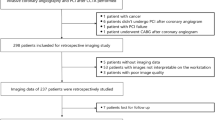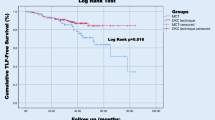Abstract
Objectives
The study aimed to investigate the prognostic value of pre-transcatheter aortic valve replacement (TAVR) computed tomography angiography (CTA) in assessing physiological stenosis severity (CTA-derived fractional flow reserve (CT-FFR)) and high-risk plaque characteristics (HRPC).
Materials and methods
Among TAVR patients who underwent pre-procedure CTA, the presence and number of HRPCs (minimum lumen area of < 4 mm2, plaque burden ≥ 70%, low-attenuating plaques, positive remodeling, napkin-ring sign, or spotty calcification) as well as CT-FFR were assessed. The risk of vessel-oriented composite outcome (VOCO, a composite of vessel-related ischemia-driven revascularization, vessel-related myocardial infarction, or cardiac death) was compared according to the number of HRPC and CT-FFR categories.
Results
Four hundred and twenty-seven patients (68.4% were male) with 1072 vessels were included. Their mean age was 70.6 ± 10.6 years. Vessels with low CT-FFR (≤ 0.80) (41.7% vs. 15.8%, adjusted hazard ratio (HRadj) 1.96; 95% confidence interval (CI): 1.28–2.96; p = 0.001) or lesions with ≥ 3 HRPC (38.7% vs. 16.0%, HRadj 1.81; 95%CI 1.20–2.71; p = 0.005) demonstrated higher VOCO risk. In the CT-FFR (> 0.80) group, lesions with ≥ 3 HRPC showed a significantly higher risk of VOCO than those with < 3 HRPC (34.7% vs. 13.0%; HRadj 2.04; 95%CI 1.18–3.52; p = 0.011). However, this relative increase in risk was not observed in vessels with positive CT-FFR (≤ 0.80).
Conclusions
In TAVR candidates, both CT-FFR and the presence of ≥ 3 HRPC were associated with an increased risk of adverse clinical events. However, the value of HRPC differed with the CT-FFR category, with more incremental predictability among vessels with negative CT-FFR but not among vessels with positive CT-FFR.
Clinical relevance statement
In transcatheter aortic valve replacement (TAVR) candidates, pre-TAVR CTA provided the opportunity to assess coronary physiological stenosis severity and high-risk plaque characteristics, both of which are associated with worse clinical outcomes.
Key Points
• The current study investigated the prognostic value of coronary physiology significance and plaque characteristics in transcatheter aortic valve replacement patients.
• The combination of coronary plaque vulnerability and physiological significance showed improved accuracy in predicting clinical outcomes in transcatheter aortic valve replacement patients.
• Pre-transcatheter aortic valve replacement CT can be a one-stop-shop tool for coronary assessments in clinical practice.





Similar content being viewed by others
Abbreviations
- AS:
-
Aortic stenosis
- CAD:
-
Coronary artery disease
- CTA:
-
Computed tomography angiography
- CT-FFR:
-
Coronary computed tomography angiography-derived fractional flow reserve
- HR:
-
Hazard ratio
- HRPC:
-
High-risk plaque characteristics
- TAVR:
-
Transcatheter aortic valve replacement
- VOCO:
-
Vessel-oriented composite outcome
References
Di Tullio MR, Jin Z, Russo C et al (2013) Patent foramen ovale, subclinical cerebrovascular disease, and ischemic stroke in a population-based cohort. J Am Coll Cardiol 62:35–41
Lunardi M, Scarsini R, Venturi G et al (2019) Physiological versus angiographic guidance for myocardial revascularization in patients undergoing transcatheter aortic valve implantation. J Am Heart Assoc 8:e012618
Ahmad Y, Gotberg M, Cook C et al (2018) Coronary hemodynamics in patients with severe aortic stenosis and coronary artery disease undergoing transcatheter aortic valve replacement: implications for clinical indices of coronary stenosis severity. JACC Cardiovasc Interv 11:2019–2031
Pesarini G, Scarsini R, Zivelonghi C et al (2016) Functional assessment of coronary artery disease in patients undergoing transcatheter aortic valve implantation: influence of pressure overload on the evaluation of lesions severity. Circ Cardiovasc Interv 9:e004088
Francone M, Budde RPJ, Bremerich J et al (2020) CT and MR imaging prior to transcatheter aortic valve implantation: standardisation of scanning protocols, measurements and reporting-a consensus document by the European Society of Cardiovascular Radiology (ESCR). Eur Radiol 30:2627–2650
Chieffo A, Giustino G, Spagnolo P et al (2015) Routine screening of coronary artery disease with computed tomographic coronary angiography in place of invasive coronary angiography in patients undergoing transcatheter aortic valve replacement. Circ Cardiovasc Interv 8:e002025
Harris BS, De Cecco CN, Schoepf UJ et al (2015) Dual-source CT imaging to plan transcatheter aortic valve replacement: accuracy for diagnosis of obstructive coronary artery disease. Radiology 275:80–88
Koo BK, Erglis A, Doh JH et al (2011) Diagnosis of ischemia-causing coronary stenoses by noninvasive fractional flow reserve computed from coronary computed tomographic angiograms. Results from the prospective multicenter DISCOVER-FLOW (Diagnosis of Ischemia-Causing Stenoses Obtained Via Noninvasive Fractional Flow Reserve) study. J Am Coll Cardiol 58:1989–1997
Min JK, Leipsic J, Pencina MJ et al (2012) Diagnostic accuracy of fractional flow reserve from anatomic CT angiography. JAMA 308:1237–1245
Motoyama S, Ito H, Sarai M et al (2015) Plaque characterization by coronary computed tomography angiography and the likelihood of acute coronary events in mid-term follow-up. J Am Coll Cardiol 66:337–346
Ferencik M, Mayrhofer T, Bittner DO et al (2018) Use of high-risk coronary atherosclerotic plaque detection for risk stratification of patients with stable chest pain: a secondary analysis of the PROMISE Randomized Clinical Trial. JAMA Cardiol 3:144–152
Norgaard BL, Terkelsen CJ, Mathiassen ON et al (2018) Coronary CT angiographic and flow reserve-guided management of patients with stable ischemic heart disease. J Am Coll Cardiol 72:2123–2134
Ihdayhid AR, Norgaard BL, Gaur S et al (2019) Prognostic value and risk continuum of noninvasive fractional flow reserve derived from coronary CT angiography. Radiology 292:343–351
Lee JM, Choi KH, Koo BK et al (2019) Prognostic implications of plaque characteristics and stenosis severity in patients with coronary artery disease. J Am Coll Cardiol 73:2413–2424
Lee SH, Hong D, Dai N et al (2022) Anatomic and hemodynamic plaque characteristics for subsequent coronary events. Front Cardiovasc Med 9:871450
Yang S, Koo BK, Hoshino M et al (2021) CT angiographic and plaque predictors of functionally significant coronary disease and outcome using machine learning. JACC Cardiovasc Imaging 14:629–641
Gohmann RF, Pawelka K, Seitz P et al (2022) Combined cCTA and TAVR planning for ruling out significant CAD: added value of ML-based CT-FFR. JACC Cardiovasc Imaging 15:476–486
Aquino GJ, Abadia AF, Schoepf UJ et al (2022) Coronary CT fractional flow reserve before transcatheter aortic valve replacement: clinical outcomes. Radiology 302:50–58
Yuan M, Wu H, Li R, Yu L, Zhang J (2020) Epicardial adipose tissue characteristics and CT high-risk plaque features: correlation with coronary thin-cap fibroatheroma determined by intravascular ultrasound. Int J Cardiovasc Imaging 36:2281–2289
Puchner SB, Liu T, Mayrhofer T et al (2014) High-risk plaque detected on coronary CT angiography predicts acute coronary syndromes independent of significant stenosis in acute chest pain: results from the ROMICAT-II trial. J Am Coll Cardiol 64:684–692
Stone GW, Maehara A, Lansky AJ et al (2011) A prospective natural-history study of coronary atherosclerosis. N Engl J Med 364:226–235
Cheng JM, Garcia-Garcia HM, de Boer SP et al (2014) In vivo detection of high-risk coronary plaques by radiofrequency intravascular ultrasound and cardiovascular outcome: results of the ATHEROREMO-IVUS study. Eur Heart J 35:639–647
Bittner DO, Mayrhofer T, Puchner SB et al (2018) Coronary computed tomography angiography-specific definitions of high-risk plaque features improve detection of acute coronary syndrome. Circ Cardiovasc Imaging 11:e007657
Piroth Z, Toth GG, Tonino PAL et al (2017) Prognostic value of fractional flow reserve measured immediately after drug-eluting stent implantation. Circ Cardiovasc Interv 10:e005233
Otto CM, Lind BK, Kitzman DW, Gersh BJ, Siscovick DS (1999) Association of aortic-valve sclerosis with cardiovascular mortality and morbidity in the elderly. N Engl J Med 341:142–147
Carabello BA, Paulus WJ (2009) Aortic stenosis. Lancet 373:956–966
Mack MJ, Leon MB, Thourani VH et al (2019) Transcatheter aortic-valve replacement with a balloon-expandable valve in low-risk patients. N Engl J Med 380:1695–1705
Popma JJ, Deeb GM, Yakubov SJ et al (2019) Transcatheter aortic-valve replacement with a self-expanding valve in low-risk patients. N Engl J Med 380:1706–1715
Smith CR, Leon MB, Mack MJ et al (2011) Transcatheter versus surgical aortic-valve replacement in high-risk patients. N Engl J Med 364:2187–2198
Adams DH, Popma JJ, Reardon MJ et al (2014) Transcatheter aortic-valve replacement with a self-expanding prosthesis. N Engl J Med 370:1790–1798
Sankaramangalam K, Banerjee K, Kandregula K et al (2017) Impact of coronary artery disease on 30-day and 1-year mortality in patients undergoing transcatheter aortic valve replacement: a meta-analysis. J Am Heart Assoc 6:e006092
Wenaweser P, Pilgrim T, Guerios E et al (2011) Impact of coronary artery disease and percutaneous coronary intervention on outcomes in patients with severe aortic stenosis undergoing transcatheter aortic valve implantation. EuroIntervention 7:541–548
Finn MT, Nazif TM, Fried J et al (2017) Coronary revascularization in patients undergoing transcatheter aortic valve replacement. Can J Cardiol 33:1099–1109
Abdel-Wahab M, Zahn R, Horack M et al (2012) Transcatheter aortic valve implantation in patients with and without concomitant coronary artery disease: comparison of characteristics and early outcome in the German multicenter TAVI registry. Clin Res Cardiol 101:973–981
Ussia GP, Barbanti M, Colombo A et al (2013) Impact of coronary artery disease in elderly patients undergoing transcatheter aortic valve implantation: insight from the Italian CoreValve Registry. Int J Cardiol 167:943–950
Stefanini GG, Stortecky S, Cao D et al (2014) Coronary artery disease severity and aortic stenosis: clinical outcomes according to SYNTAX score in patients undergoing transcatheter aortic valve implantation. Eur Heart J 35:2530–2540
Witberg G, Regev E, Chen S et al (2017) The prognostic effects of coronary disease severity and completeness of revascularization on mortality in patients undergoing transcatheter aortic valve replacement. JACC Cardiovasc Interv 10:1428–1435
Blanke P, Weir-McCall JR, Achenbach S et al (2019) Computed tomography imaging in the context of transcatheter aortic valve implantation (TAVI)/transcatheter aortic valve replacement (TAVR): an expert consensus document of the Society of Cardiovascular Computed Tomography. JACC Cardiovasc Imaging 12:1–24
Leipsic J, Gurvitch R, Labounty TM et al (2011) Multidetector computed tomography in transcatheter aortic valve implantation. JACC Cardiovasc Imaging 4:416–429
Peper J, Becker LM, van den Berg H et al (2022) Diagnostic performance of CCTA and CT-FFR for the detection of CAD in TAVR work-up. JACC Cardiovasc Interv 15:1140–1149
Serruys PW, Hara H, Garg S et al (2021) Coronary computed tomographic angiography for complete assessment of coronary artery disease: JACC state-of-the-art review. J Am Coll Cardiol 78:713–736
Xaplanteris P, Fournier S, Pijls NHJ et al (2018) Five-year outcomes with PCI guided by fractional flow reserve. N Engl J Med 379:250–259
Virmani R, Burke AP, Farb A, Kolodgie FD (2006) Pathology of the vulnerable plaque. J Am Coll Cardiol 47:C13-18
Michiels V, Andreini D, Conte E et al (2022) Long term effects of surgical and transcatheter aortic valve replacement on FFR(CT) in patients with severe aortic valve stenosis. Int J Cardiovasc Imaging 38:427–434
Funding
This study has received funding by National Key Research and Development Program of China (2021YFC2500500 and 2020YFC1316700), Shanghai Clinical Research Center for Interventional Medicine (No. 19MC1910300), Shanghai Municipal Key Clinical Specialty (No. shslczdzk01701), and National Natural Science Foundation of China (Grant No. 82370513).
Author information
Authors and Affiliations
Corresponding authors
Ethics declarations
Guarantor
The scientific guarantor of this publication is Junbo Ge.
Conflict of interest
S.D. works for GE Healthcare China. The remaining authors of this manuscript declare no relationships with any companies whose products or services may be related to the subject matter of the article.
Statistics and biometry
One of the authors has significant statistical expertise.
Informed consent
Written informed consent was obtained from all subjects (patients) in this study.
Ethical approval
Institutional Review Board approval was obtained.
Study subjects or cohorts overlap
No overlap.
Methodology
• retrospective
• diagnostic or prognostic study
• performed at one institution
Additional information
Publisher's Note
Springer Nature remains neutral with regard to jurisdictional claims in published maps and institutional affiliations.
The work was performed at Zhongshan Hospital, Fudan University, Shanghai, China.
Supplementary Information
Below is the link to the electronic supplementary material.
Rights and permissions
Springer Nature or its licensor (e.g. a society or other partner) holds exclusive rights to this article under a publishing agreement with the author(s) or other rightsholder(s); author self-archiving of the accepted manuscript version of this article is solely governed by the terms of such publishing agreement and applicable law.
About this article
Cite this article
Dai, N., Tang, X., Ling, R. et al. Prognostic implications of pre-transcatheter aortic valve replacement computed tomography-derived coronary plaque characteristics and stenosis severity. Eur Radiol (2024). https://doi.org/10.1007/s00330-024-10633-7
Received:
Revised:
Accepted:
Published:
DOI: https://doi.org/10.1007/s00330-024-10633-7




